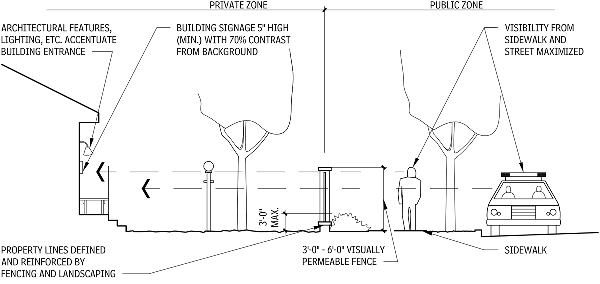Table Of Content
- of crime. It is smart planning to anticipate potential crime issues and design
- What Is CPTED and How Can It Help Your Community?
- Safe and Healthy Communities
- necessary arrangements to train you in the concepts of Crime Prevention Through
- Subdivisions and Office Parks
- Opinion: Grocery stores used to be my happy place. Then they started locking up the detergent
- Safest Los Angeles Area Neighborhoods
- Los Angeles Annual Crimes

Retail crime has also been reduced by, for instance, configuring and reducing the height of aisles so staff can see them more easily. Strategies can be as simple as good maintenance, like rapidly removing graffiti, which can deter some offenders. Second Generation concepts drew from the emerging sociological research on “collective efficacy” and land use capacity (Saville & Wong, 1991; 1994; Ministry of Justice, 1994; Sampson and Lauritson, 1990; 1994; Spelman, 1992; Gillis, 1974). It also included principles of political connectedness and culture that appear in subsequent literature (Kilburn et al., 2014). A project co-funded by the European Union Prevention of and Fight against Crime Programme of the European Union has developed and implemented this manual for police throughout Europe and internationally. In 1997, an article by Greg Saville and Gerry Cleveland, 2nd Generation CPTED, exhorted CPTED practitioners to consider the original social ecology origins of CPTED, including social and psychological issues beyond the built environment.
of crime. It is smart planning to anticipate potential crime issues and design
Because the Design Out Crime initiative has only been fully underway for about 18 months and represents a preventative approach to crime, its crime reductions may be difficult to quantify. Many projects currently being processed through the City’s development approval process have incorporated the Design Out Crime techniques. However, since the program remains in an early phase, many of the projects reviewed under this initiative have not been completed. Future crime statistics in the area of these projects could prove useful indicators of the relative success of these efforts.
What Is CPTED and How Can It Help Your Community?
Observer Actors — These actors are still considered to be positive users and are as important as normal actors, with a casual inclination. Designing space for observers is essential and equally important to ensuring the safety of those merely passing through or just enjoying a lunch break. Normal Actors — In parks and recreation, these are the frequent visitors, volunteers, runners, hikers, fishermen/women, bicyclists, program attendees, who use a facility. You want to focus your efforts on assuring that your normal users continue to be positively engaged with your organization. It is important to avoid creating hiding spaces in alleys, storage yards, and loading areas. For example, although in some cases hedges can define spaces, they also have the potential to provide convenient hidings spaces if placed too close together.

Safe and Healthy Communities

The insertion of target hardening into CPTED, and the removal of motive reinforcement, signaled a shift away from social cohesion and neighborhood renewal toward a focus on physical, crime-opportunity reduction. This was informed, no doubt, by academic studies beginning in the late 1970s and early 1980s about crime and opportunities. “In the seventies, offender-based research started to focus on the rational spatial and environmental choices made by offenders.” (van Soomeren, 1996). CPTED strategies aim to reduce victimization, deter offender decisions that precede criminal acts, and build a sense of community among inhabitants so they can gain territorial control of areas, reduce crime, and minimize fear of crime. Territorial reinforcement promotes social control through increased definition of space and improved proprietary concern.An environment designed to clearly delineate private space does two things.
These principles were used in the Perth City Link project, reconnecting the central business district with the entertainment district by sinking the railway line. In 1973, architect Oscar Newman led a ground-breaking study comparing two New York social housing projects. Van Dyke (a high-rise building) had crime rates more than double those of Brownsville (a low-rise building). Given the similarity in populations, Newman argued the physical design of the buildings could explain this difference in crime. As with all CPTED principles, there are no single strategies that will reduce all crime; they should be applied in combinations based on a thorough analysis of the local context. However, the history of CPTED suggests that comprehensive urban planning and community development requires consideration of all First and Second Generation CPTED principles.
Subdivisions and Office Parks
Colorado Program Fixes Broken Streetlights Instead of Arresting People for Broken Windows — Streetsblog USA - Streetsblog USA
Colorado Program Fixes Broken Streetlights Instead of Arresting People for Broken Windows — Streetsblog USA.
Posted: Thu, 06 Apr 2023 07:00:00 GMT [source]
To combat theft, Budano said, companies often scrutinize missing merchandise using individual SKUs, the most granular data possible. More than 40 retailers are testing the Freedom Case in stores, Budano said, including a national chain he declined to name. Representatives for several of the region’s largest retailers — Target, Vons, Rite Aid and CVS — either didn’t respond to requests to discuss internal deliberations on stemming theft or sent brief statements about their anti-theft measures. While the companies work publicly to change California law, they are taciturn about discussing their efforts to stop shoplifters, making it hard to quantify how much more merchandise is now locked up and which stores have embraced the strategy.
Surveillance is enhanced by lighting, proper placement of shrubbery, well-placed windows, elimination of physical barriers, and architecture and social commitment. The scale of merchandise theft, Kubrin added, is sometimes overblown by a retail industry happy to pin its problems, which include market forces such as inflation and a shift to online shopping, on stolen merchandise. Charis Kubrin, a professor of criminology at UC Irvine who studies retail theft, said that although some stores lock up lots of merchandise, others cage almost nothing.
Safest Los Angeles Area Neighborhoods
Legitimate activity for a space or dwelling is encouraged through the use of natural surveillance and lighting, and architectural design that clearly defines the purpose of the structure or space. Crime prevention and design strategies can discourage illegal activity and protect a property from chronic problem activity. A design concept intended to make intruders easily observable, natural surveillance is promoted by features that maximize visibility of people, parking areas, and entrances. Examples are doors and windows that look onto streets and parking areas, pedestrian-friendly sidewalks and streets, front porches, and adequate nighttime lighting. Security design and access control is more than bars on windows, a security guard booth, a camera, or a wall. Crime prevention involves the systematic integration of design, technology, and operation for the protection of three critical assets-people, information, and property.
Los Angeles Annual Crimes
CPTED takes advantage of opportunities for natural access control, surveillance, and territorial reinforcement. It is possible for natural and normal uses of the environment to meet the same security goals as physical and technical protection methods. The first paper by Paul Cozens and Tom Davies analyses the effectiveness of actual products developed for crime prevention – in this case security shutters in a residential setting.
The ideas behind Crime Prevention and Environmental Design (CPTED) are highlighted and questioned in relation to perceptions of safety as well as SCP techniques. The authors argue that the clustering of shuttered properties could signal the emergence of a fortress suburb in response to an ‘anxiety market’ that has heightened the fear and perception of crime rather than an actual increase in residential burglaries. Crime Prevention Through Environmental Design (CPTED) is an approach to crime reduction that seeks to reduce perceived opportunities for crime through the design and management of the built or, less often, the natural environment.
The goal is to create safe places through limited access to properties, good surveillance, and a sense of ownership and responsibility. One strategy is known as Crime Prevention Through Environmental Design (CPTED, pronounced “sep-ted”). This approach is based on the idea that specific built and social environmental features can deter criminal behaviour. Benefits of the ProgramThe Design Out Crime initiative will benefit every Los Angeles resident.
This was a FREE conference where security professionals from around the world met and shared ideas on how to combat graffiti by Crime Prevention Through Environmental Design. For additional information, case studies, and tools about collaborative responses to crime that include CPTED, visit LISC’s Community Safety Resource Center. It is important to find the proper balance between the desire for seclusion and the aspect of safety.
These strategies are context-specific and must work together in order to be most effective. How does the crime rate in Los Angeles compare to similar sized communities across America? When NeighborhoodScout compared Los Angeles with other communities its size, we found that the crime rate was near the average for all other communities of similar size. Failure to assess crime risks before implementing solutions can result in poor outcomes that don’t deal with the local issues, which can make these worse and waste resources. In the Netherlands, the risk of residential burglary fell by 95% in new estates and 80% in existing homes after these ideas were implemented as a wider wave of crime prevention in the late 1980s.

No comments:
Post a Comment